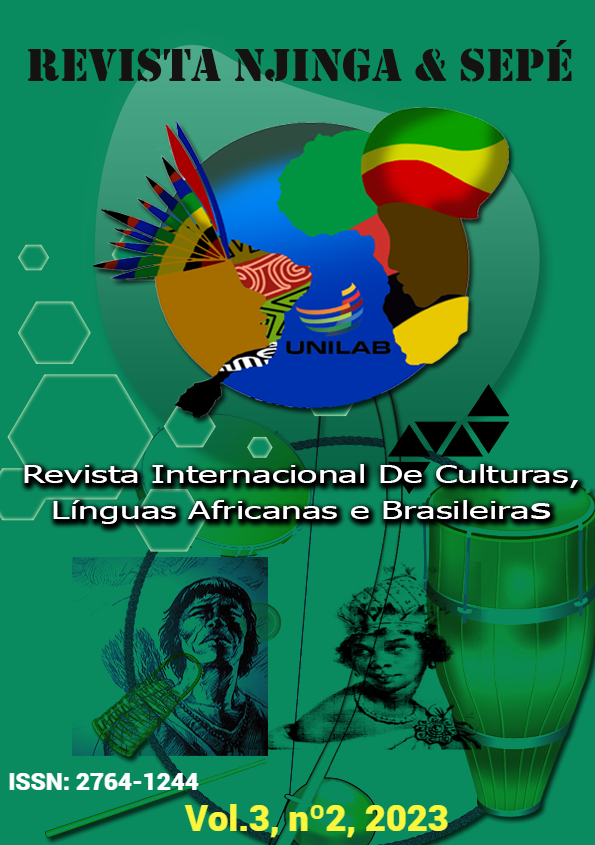A figura do Índio no Romantismo Brasileiro: um olhar sobre o romance Iracema, de José de Alencar
The figure of the Indian in Brazilian Romanticism: a look at the novel Iracema, by José de Alencar
Mots-clés :
Brasilidade, Indianismo, Literatura, RomantismoRésumé
Numa perspectiva literária, este estudo pretende analisar, dentro da produção literária brasileira, em exclusivo a obra Iracema, um romance de carácter indianista, “a figura do Índio no Romantismo Brasileiro”. Tal perspectiva assenta no pressuposto do ideal nacionalista e o processo de construção da nação brasileira empreendida pela relevância e perseverança do movimento romântico no início do século XIX. O romance “Iracema” foi publicado em 1865 e pertence ao movimento Romântico Brasileiro e o estilo que apruma é da actualidade dada a relevância que exerce no bloco das literaturas nativistas e orientada por uma exaltação da identidade patriótica. A par deste cenário, faz-se uma incursão em torno do encontro intercultural entre dois mundos adversos, ou seja, cruzamento de polos diferentes “o europeu e o índio”, pondo em evidência as relações de homogeneização, que contribuem para o fracasso do processo de construção da nação mestiça “Brasil”. Nesse contexto, dada a natureza desta pesquisa, para a concretização do objectivo delineado neste artigo, recorreu-se ao método de análise de conteúdo e recorreu-se também ao método bibliográfico. Para tal, convocou-se, para este estudo, várias obras, mas com maior primazia às obras de Aguiar e Silva (2011); Alencar (2007) e Buescu (1997).
***
From a literary perspective, this study intends to analyze, within the Brazilian literary production, exclusively the book Iracema, a novel with an Indianist character, the figure of the Indian in Brazilian Romanticism. This perspective is based on the assumption of the nationalist ideal and the process of construction of the Brazilian nation undertaken by the relevance and perseverance of the romantic movement in the early 19th century. The novel Iracema was published in 1865 and belongs to the Brazilian Romantic movement and the style it adopts is current given the relevance it exercises in the block of nativist literature and guided by an exaltation of patriotic identity. Alongside this scenario, an incursion is made around the intercultural encounter between two adverse worlds, that is, the crossing of different poles “the European and the Indian”, highlighting the homogenization relations, which contribute to the failure of the process construction of the mestizo nation “Brazil”. In this context, due to the nature of this research, to achieve the objective outlined in this article, the content analysis method was used and the bibliographic method was also used. To this end, several books were summoned for this study, but with greater primacy to the books by Aguiar e Silva (2011); Alencar (2007) and Buescu (1997).
Téléchargements
Références
Aguiar e Silva, V. M. de. (2011). Teoria da Literatura. 8.ed. Coimbra: Livraria Almedina.
Alencar, J. de. (2007). Iracema: lenda do Ceará. São Paulo, Campinas-SP: Edição Komedi, 2007.
Buescu, H. (1997). Dicionário do Romantismo Literário Português. Lisboa: Caminho.
Oliveira, M. F. de. (2005). Significações Históricas do “Índio”. 145f. (Dissertação) Instituto de Letras. Universidade de Bahia. São Paulo.
Ramos, I. P. (2006). Ubirajara: Ficҫão e Ficҫões Alencarianas. 150f. (Dissertação). Faculdade de Letras. Universidade Federal de Minas Gerais. Belo Horizonte.
Todorov, T. (2003). A Conquista da América: a Questão do Outro. São Paulo: Martins Fontes.
Téléchargements
Publiée
Comment citer
Numéro
Rubrique
Licence
(c) Tous droits réservés NJINGA&SEPÉ: Revista Internacional de Culturas, Línguas Africanas e Brasileiras 2023

Ce travail est disponible sous licence Creative Commons Attribution - Pas d'Utilisation Commerciale - Pas de Modification 4.0 International.
Les auteurs qui publient dans cette revue acceptent les conditions suivantes:
Les auteurs conservent le droit d'auteur et accordent à la revue le droit de première publication, l'œuvre étant simultanément concédée sous licence Creative Commons Attribution License, qui permet le partage de l'œuvre avec reconnaissance de la paternité de l'œuvre et publication initiale dans ce magazine.
Les auteurs sont autorisés à assumer séparément des contrats supplémentaires, pour la distribution non exclusive de la version de l'ouvrage publié dans cette revue (par exemple, publication dans un référentiel institutionnel ou en tant que chapitre de livre), avec reconnaissance de la paternité et publication initiale dans cette revue.
Les auteurs sont autorisés et encouragés à publier et distribuer leurs travaux en ligne (par exemple dans des référentiels institutionnels ou sur leur page personnelle) à tout moment avant ou pendant le processus éditorial, car cela peut générer des changements productifs, ainsi que citation des travaux publiés (voir l'effet du libre accès).




